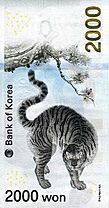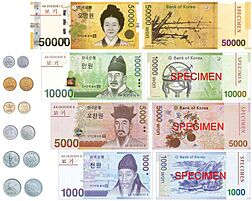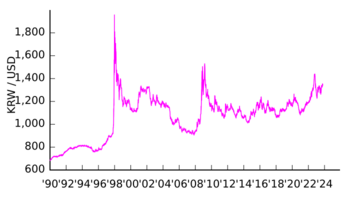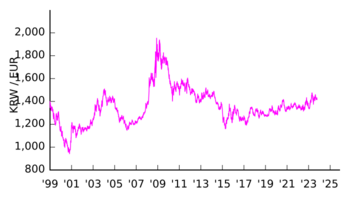South Korean won facts for kids
Quick facts for kids South Korean won |
|||
|---|---|---|---|
|
|||
| ISO 4217 Code | KRW | ||
| User(s) | South Korea | ||
| Inflation | 2.4% (June 2024) | ||
| Subunit | |||
| 1⁄100 | jeon (전/錢) Theoretical (not used) |
||
| Symbol | ₩ | ||
| Plural | The language(s) of this currency does not have a morphological plural distinction. | ||
| Coins | 1, 5, 10, 50, 100, 500 | ||
| Banknotes | 1000, 2000, 5000, 10000, 50000 | ||
| Printer | Korea Minting and Security Printing Corporation | ||
| South Korean won | |
| Hangul | |
|---|---|
| Hanja |
大韓民國 원
|
| Revised Romanization | Daehanmin(-)guk won |
| McCune–Reischauer | Taehanmin'guk wŏn |
| The current won (원) does not officially have any hanja associated with it. | |
The South Korean won (Symbol: ₩; Code: KRW; Korean: 대한민국 원) is the official money of South Korea. One won is made up of 100 jeon. However, jeon are not used in daily life anymore. You only see them in international money exchange rates. The Bank of Korea, located in Seoul, is in charge of making and distributing the won.
Contents
What's in a Name?
The word "won" is related to the Chinese yuan and Japanese yen. All these names came from the old Spanish dollar. The word "won" comes from a Chinese character (hanja) that means "round." This describes the shape of the silver dollar coins used long ago.
The won used to be divided into 100 jeon. The word jeon is also related to a Chinese word for a small weight unit, and it means money in general. Today, the word "won" is only written in Korean (hangul) and does not use the old Chinese characters.
First South Korean Won (1945–1953)
A Brief History of the Won
The Korean won, Chinese yuan, and Japanese yen all came from the Spanish dollar. This silver coin was very popular for trade between Asia and the Americas from the 1500s to the 1800s.
During the time Korea was ruled by Japan (1910–1945), the won was replaced by the Korean yen. This yen had the same value as the Japanese yen.
After World War II ended in 1945, Korea was split into two parts. This led to two different currencies, both called won, for South Korea and North Korea. Both the first South Korean won and the North Korean won took the place of the yen. The first South Korean won was divided into 100 jeon.
The first South Korean won was initially set at a fixed value against the U.S. dollar. It was 15 won for 1 dollar. But its value changed many times, especially during the Korean War (1950–1953).
The first South Korean won was replaced by a new currency called the hwan on February 15, 1953. One hwan was worth 100 won.
Old Banknotes
In 1946, the Bank of Joseon printed 10 and 100 won banknotes. Later, in 1949, they added 5 and 1,000 won notes.
A new bank, the Bank of Korea, started on June 12, 1950. It took over from the Bank of Joseon. They printed notes for 5, 10, and 50 jeon, and 100 and 1,000 won. In 1952, 500 won notes were added. In 1953, some banknotes were printed that said "won" in English, but they were actually the first hwan notes.
Second South Korean Won (1962–Present)
Modern Won History
The won was brought back on June 10, 1962. One won was equal to 10 hwan. It became the only legal money on March 22, 1975, when the last hwan coins were removed from use. Its international code is KRW. When the won returned in 1962, its value was set at 125 won for 1 US dollar.
On February 27, 1980, South Korea started to let the won's value change more freely. The won was finally allowed to "float" (meaning its value was set by the market) on December 24, 1997. This happened after an agreement with the International Monetary Fund. Soon after, during the 1997 Asian financial crisis, the won lost almost half its value.
Coins of South Korea
Before 1966, only 10 and 50 hwan coins were used, but they were revalued as 1 and 5 won. New coins, called won, were released by the Bank of Korea on August 16, 1966. These were 1, 5, and 10 won coins. The 1 won coin was made of brass, and the 5 and 10 won coins were bronze. These were the first South Korean coins to show the date using the regular calendar, not the Korean calendar. The old hwan coins were stopped on March 22, 1975.
In 1968, the 1 won brass coin became too expensive to make. So, new 1 won coins made of aluminum were created. To save more money, new 5 and 10 won coins made of brass were issued in 1970. Copper-nickel 100 won coins came out that same year, followed by 50 won coins in 1972.
In 1982, with prices going up and more vending machines being used, 500 won coins were introduced. In January 1983, to make all coins look similar, new 1, 5, 10, 50, and 100 won coins were released. They looked like the 500 won coin but kept their original designs.
The Bank of Korea decided to change the 10 won coin in 2006. It cost 38 won to make a 10 won coin, which was more than its value! People even rumored that some were melting the coins to make jewelry. The new 10 won coin is smaller and made of copper-coated aluminum. It looks the same but costs less to make. This new coin was released on December 18, 2006.
The 1 and 5 won coins are rarely used in daily life since 1992. Prices are usually rounded to the nearest 10 won. However, these coins are still made in small numbers each year for special coin collector sets.
| Current coins | |||||||||||
|---|---|---|---|---|---|---|---|---|---|---|---|
| Image | Value | Technical parameters | Description | Date of | BOK series designation | ||||||
| Obverse | Reverse | Diameter | Mass | Composition | Edge | Obverse | Reverse | First minting | Issue | ||
| ₩10 | 18 mm | 1.22 g | Copper-plated aluminium 48% copper 52% aluminium |
Plain | Dabotap pagoda, value (hangul) | Value (digit), bank title, year of minting | 2006 | December 18, 2006 | Series IV (라) | ||
 |
 |
₩50 | 21.6 mm | 4.16 g | 70% copper 18% zinc 12% nickel |
Reeded | Stalk of rice, value (hangul) | Value (digit), bank title, year of minting | 1983 | January 15, 1983 | Series II (나) |
 |
 |
₩100 | 24 mm | 5.42 g | Cupronickel 75% copper 25% nickel |
Yi Sun-sin, value (hangul) | |||||
 |
 |
₩500 | 26.5 mm | 7.7 g | Red-crowned crane, value (hangul) | 1982 | June 12, 1982 | Series I (가) | |||
| These images are to scale at 2.5 pixels per millimetre. For table standards, see the coin specification table. | |||||||||||
Banknotes of South Korea
The Bank of Korea names its banknote and coin series in a special way. Instead of grouping them by design, they give a series number to each new design of a certain value. For example, a 1,000 won note from 1983 is "Series II" because it's the second design for 1,000 won notes since 1962.
In 1962, the Bank of Korea released 10 and 50 jeon notes, and 1, 5, 10, 50, 100, and 500 won notes. The first 1, 5, 10, 50, 100, and 500 won notes were printed in the United Kingdom. The jeon notes and a second set of 10 and 100 won notes were printed in Korea.
In 1965, 100 won notes (Series III) were printed using a special technique called intaglio printing. This was the first time this was done in Korea, and it helped prevent fake money. New 500 won notes followed in 1966, also using intaglio printing. In 1969, new 50 won notes were printed using lithoprinting.
As the economy grew in the 1960s, the 500 won notes became less valuable. People started using larger cashier's checks more often. Also, there were more fake 500 won notes. In 1970, 100 won notes were replaced by coins, and the same happened to 50 won notes in 1972.
Higher value notes, 5,000 and 10,000 won, were introduced in 1972 and 1973. These notes had new security features like watermarks, security threads, and special fibers that glow under ultraviolet light. They were also printed using intaglio. The 10,000 won note was supposed to come out with the 5,000 won note, but there were delays. New 500 won notes were also released in 1973. In 1975, 1,000 won notes were introduced to fill the gap between smaller and larger values.
In 1982, the 500 won note was replaced by a coin. The next year, the Bank of Korea released new sets of notes and coins. These new notes had special marks for blind people and machine-readable features. They were also printed on better quality paper to last longer and save money.
To deal with new color printers and scanners, updated 5,000 and 10,000 won notes were released between 1994 and 2002. These had many new security features. These included ink that changes color, tiny writing (microprint), special metal threads, and patterns that prevent copying. The newest 5,000 and 10,000 won notes have copyright information printed on them.
| 1983–2002 Series | |||||||||||
|---|---|---|---|---|---|---|---|---|---|---|---|
| Image | Value | Dimensions | Main Color | Description | Date of issue | Suspended Date | BOK series designation | Modification | |||
| Obverse | Reverse | Obverse | Reverse | Watermark | |||||||
 |
 |
₩1,000 | 151 × 76 mm | Purple | Yi Hwang | Dosan Seowon (Dosan Confucian Academy) | Reversed portrait | June 11, 1983 | June 1, 2016 | Series II (나) | |
 |
 |
₩5,000 | 156 × 76 mm | Orange | Yi I | Ojukheon in Gangneung | June 11, 1983 | Series III (다) | |||
 |
 |
June 12, 2002 | Series IV (라) | Color-shifting ink on the dots for blinds, segmented metal thread, copyright inscription | |||||||
 |
 |
₩10,000 | 161 × 76 mm | Green | Sejong the Great, Water clock | Gyeonghoeru Pavilion at Gyeongbok Palace | October 8, 1983 | Series III (다) | |||
 |
 |
January 20, 1994 | Series IV (라) | Segmented metal thread, microprint under the water clock, moiré on watermark area, intaglio latent image | |||||||
 |
 |
Reversed portrait, Taeguk | June 19, 2000 | Series V (마) | Color-shifting ink on the dots for blinds, removal of moiré, EURion constellation, copyright inscription | ||||||
| These images are to scale at 0.7 pixel per millimetre. For table standards, see the banknote specification table. | |||||||||||
New Security Features
In 2006, there was a big problem with fake South Korean won banknotes. This led the government to create a new series of banknotes with better security. The 5,000 won note was the first to be redesigned. Then, in 2007, the 1,000 and 10,000 won notes were released.
On June 23, 2009, the Bank of Korea released the 50,000 won note. This note features Shin Saimdang, a famous artist from the 1500s. She was also the mother of Yulgok, who is on the 5,000 won note. This was the first time a woman was featured on a Korean banknote.
These new banknotes have many security features. The 50,000 won note has 22 security features, the 10,000 won note has 21, and the 1,000 won note has 19. Many of these features are also found in other major currencies like the euro and Japanese yen.
Some of the security features include:
- Holograms: These are 3D images that change colors on the front of the notes (except the ₩1,000).
- Watermarks: You can see a hidden picture of the person on the note when you hold it up to the light.
- Raised Printing: The words and pictures feel bumpy, different from regular paper.
- Security Thread: A special thread is woven into the paper on the right side of the note. It has tiny words like "Bank of Korea" and the note's value.
- Color-Shifting Ink: The value number on the back of the note changes color when you tilt it.
The Korean mint, KOMSCO, even developed a new way to detect fake money. This technology is now being used by other countries too!
| 2006 Series | |||||||||
|---|---|---|---|---|---|---|---|---|---|
| Image | Value | Dimensions | Main color | Description | Date of issue | BOK series designation | |||
| Obverse | Reverse | Obverse | Reverse | Watermark | |||||
| ₩1,000 | 136 × 68 mm | Blue | Yi Hwang, Myeongryundang in Seonggyungwan, plum flowers | "Gyesangjeonggeodo"; a painting Yi Hwang in Dosan Seowon by Jeong Seon | Reversed portrait and electrotype denomination (₩1,000 to ₩50,000) | January 22, 2007 | Series III (다) | ||
| ₩5,000 | 142 × 68 mm | Orange | Yi I, Ojukheon in Gangneung, black bamboo | "Insects and Plants", a painting of a watermelon and cockscombs by Yi I's mother Shin Saimdang | January 2, 2006 | Series V (마) | |||
| ₩10,000 | 148 × 68 mm | Green | Sejong the Great, Irworobongdo, a folding screen for Joseon-era kings, and text from the second chapter of Yongbieocheonga, the first work of literature written in hangul | Globe of Honcheonsigye, Cheonsang Yeolcha Bunyajido C14 star map and reflecting telescope at Bohyeonsan Observatory in the background | January 22, 2007 | Series VI (바) | |||
| ₩50,000 | 154 × 68 mm | Yellow | Shin Saimdang with Chochungdo - a Folding Screen of Embroidered Plants and Insects (South Korean National Treasure No. 595) in the background | Bamboo and a plum tree | June 23, 2009 | Series I (가) | |||
| These images are to scale at 0.7 pixel per millimetre. For table standards, see the banknote specification table. | |||||||||
| 2017 Commemorative Series | |||||||||
|---|---|---|---|---|---|---|---|---|---|
| Image | Value | Dimensions | Main color | Description | Date of issue | BOK series designation | |||
| Obverse | Reverse | Obverse | Reverse | Watermark | |||||
 |
₩2,000 | 140 x 75 mm | Gray | Seven winter sports events (Biathlon, Ice hockey, Curling, Speed skating, Ski jumping, Luge and Bobsled) | Songhamaenghodo (a painting of a tiger and a pine tree by Joseon-era artist Kim Hong-do) | Pyeongchang Olympic Stadium | November 17, 2017 | Series I (가) | |
| These images are to scale at 0.7 pixel per millimetre. For table standards, see the banknote specification table. | |||||||||
The Future of the Won
Going Coinless?
South Korea is using more and more electronic payments. Because of this, people are using coins less often. The Bank of Korea started a test program to stop making coins completely. Instead of getting change in coins, people could have it added to their prepaid cards. However, fewer people are joining this program now.
Changing the Won's Value?
There have been ideas in the South Korean government to change the won's value. This would mean making a new won that is worth 1,000 old won, almost equal to one U.S. dollar. Supporters say a higher value currency would show how strong the country's economy is. But most people are against this idea. They worry it could harm the economy if done too quickly. They also believe there are more important economic issues to focus on.
How Money is Made
The Bank of Korea is the only place in South Korea allowed to print banknotes and make coins. The money is printed at KOMSCO, a company owned by the government. KOMSCO follows the instructions from the Bank of Korea.
After new money is printed or minted, it's bundled up and sent to the Bank of Korea's main office. It's stored in the bank's vault until commercial banks ask for it.
Every year, around the big Korean holidays like Seollal (Lunar New Year) and Chuseok (Harvest Festival), the Bank of Korea sends a lot of money to commercial banks. These banks then give the money to their customers when they ask for it.
Current Exchange Rates
More to Explore
- Economy of South Korea
- Korean currency
- North Korean won
- All Banknotes issued in Korea





